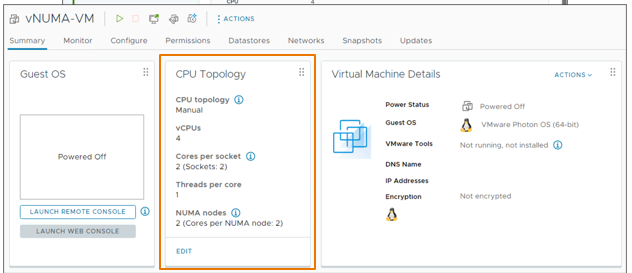VMware vSphere 8 has already been with us for a few months and, after this time, we are discovering new features as this version is being rapidly adopted . There are many changes and improvements, from my point of view, these would be some of them regarding the administration and operation of vSphere:
vNUMA Configuration and Visualization
Interesting candy we have here. Rarely considered, but with a high importance for the performance is the existing NUMA Nodes and their perfect alignment with the vCPUs of our Virtual Machine. It’s only when we perform a Healthcheck of the environment or a performance study that we remember this concept, which has existed since vSphere 5.0. In vSphere 8 and under the Virtual Hardware 20, it is possible to configure the NUMA topology from the vSphere Client, thanks to a new tab in Summary, called CPU Topology

Staging Cluster Images
Just like we did with Update Manager Baselines, now it’s possible to stage the ESXi images of a cluster for later Remediation. We can do it for all the hosts in a cluster with just one click. Moreover, it is no longer necessary for them to be in Maintenance Mode to perform this task.

Parallel Remediation
Why update only one host when you can do several at once? In vSphere 8 we can perform the ESXi Remediation in parallel. We decide which hosts to put in MM and the Lifecycle Manager will take care of the process applying the Remediation on those hosts, up to a total of 10. Easy and painless.

Enhanced Recovery of vCenter
Another sweet candy. Do you remember the divine punishment of restoring a vCenter from Backup? Well first of all. Do you Backup your vCenter Server? If the answer is “No”, well, stop reading, go directly to the VAMI and make a backup to your favorite SFTP. As a wise man said “Your restore will fail if there is no Backup”. Anyway, Here’s another great improvement when restoring your cluster from vCSA.

After start a restore operations, If there have been changes in our clusters since the backup was made, inconsistencies can occur during the restoration process but. in vSphere 8 our newly restored vCenter is able to identify what is missing in its inventory and update itself with real-time data. This is achieved by distributing information portions among the ESX called DKVS or Distributed Key-Value Store
DRS and Persistent Memory
In vSphere 8, DRS performs an analysis of memory usage by various workloads using PMEM (Persistent Memory). As a result, migration in this way does not affect performance.

vSphere Configuration Profiles
In the same way that we used Host Profiles to quickly configure new Hypervisors, vSphere 8 presents vSphere Configuration Profiles. This time to be able to define configuration elements of the objects in a cluster. Very similar to how the already mentioned LCM Cluster Images work. There is a lot to try here if we can really use those configuration objects to later apply them to another cluster.

Enough for today. But there would be more things to come. Next time I will comment on news related to vSAN 8.